Copyright der Übersetzungen ins deutsche: Gaby Creswell, Jewels of Thai
(scroll to the bottom of page for English)
Schaut mal HIER für tolle photos alter Katzen, so stellen wir
uns eine Traditionelle Siam (Thai) vor:
http://daisuki-thai.de/infos/beruehmte-vorfahren-unserer-katzen/
TICA Thai
Standard, Stand 1 Mai 2010
|
Punkteskala |
|
|
KOPF Form Profil & Nase Augen Ohren Schnauze & Kinn Nacken |
40 points 15 5 4 7 7 2 |
|
KÖRPER:
Rumpf Beine & Pfoten Schwanz Körper(Knochen)bau Muskulatur |
40 points 15 8 5 8 4 |
|
Fell/Farbe/Zeichnung Textur und Länge Körperfarbe |
20 points 15 5 |
Kategorie: Point
Division: Solid, Tabby, und Tortie
Farben: Alle
Erlaubter Outcross: Siam
|
KOPF |
||
|
Form |
Modifizierter Keil von mittlerer Breite mit runden Wangen und sich verjüngender Schnauze. Der Kopf ist länger als breit, aber nicht extrem oder schmal. Wangenknochen sind Richtung Schnauze nach innen wo die Schnauze beginnt gerundet. Schnauze ist keilförmig, aber abgerundet wie ein sich verjüngender Gartenspaten. Stirn ist flach und lang. |
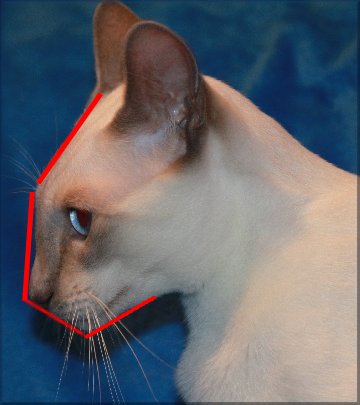 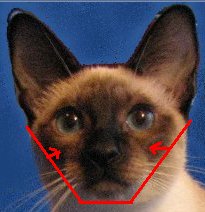
|
|
Profil Nase |
Nahezu gerade, aber mit leichtem Gefälle ab knapp oberhalb der Augen. Im Profil darf die Nase gerade oder leicht konvex sein. |
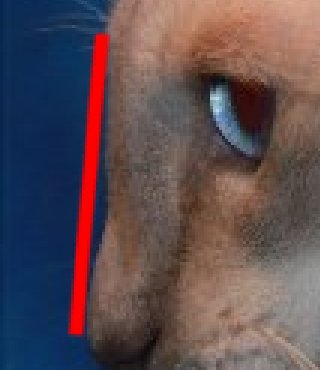 |
|
Augen |
Mittel bis leicht groß, sehr volle mandelform, nicht orientalisch. Augenstand etwas mehr als eine Augebreite auseinander. Eine Linie vom inneren Augenwinkel durch den äußeren Augenwinkel trifft die äußere Basis des Ohres. |
 |
|
Augenfarbe |
Blau. Tiefblaue Schattierungen bevorzugt. Intensität und Leuchtkraft sind wichtiger als Farbtiefe. |
 |
|
Ohren |
Mittelgroß bis groß, breit an der Basis, mit ovalen Spitzen. Ohrenspitzen zeigen nach aussen in einem Winkel der etwas näher an der Kopf Oberseite ist als seitlich des Kopfes (35 Grad von der Senkrechten). Leichte Behaarung erlaubt. |
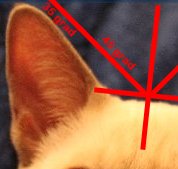 |
|
Schnauze |
Mittellang bis lang. Keilförmig: sich zur Nase hin verjüngenden Seiten mit gerundetem Abschluss. Leichte oder keine Schnurrhaareinbuchtung. Mittel-Stark. |
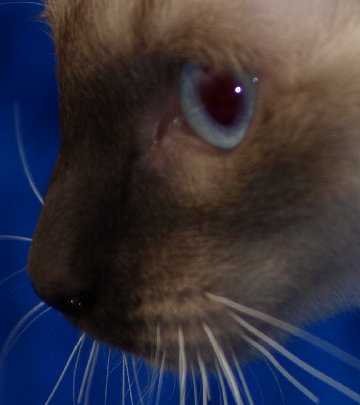 |
|
Kinn |
Weder schwach noch zu stark, senkrecht mit der Nase ausgerichtet. | |
|
Nacken |
Von mittlerer Länge, weder dünn noch übermäßig muskulös. | |
|
Körper |
||
| Rumpf | Mässig lang, geschmeidig und anmutig wie ein kleiner Panther. Gut proportioniert aber weder röhrenförmig noch gedrungen. Hoch genug auf den Beinen für den gewünschten orientalischen Typ. Unterbauch verläuft weitgehendst parallel zum Boden und ist straff. Allerdings ist eine geringe Menge loser Haut am Unterbauch unterhalb der Flanke zulässig | |
| Beine | Mittellang, von anmutiger Form, aber nicht plump | |
| Pfoten | Ovale Form, mittlere Größe im Verhältnis zur Katze | |
| Schwanz | So lang wie der Rumpf, verjüngt sich allmählich zur Spitze | |
| Körperbau | Medium. Anmutig. Weder dünn noch plump. | |
| Muskulatur | Fest, aber geschmeidig, nicht fleischig oder dick. Wenn die Katze hochgehoben wird, wiegt sie etwa so viel, oder etwas mehr, als man aufgrund ihres Aussehens vorhersagen würde. | |
|
Fell/Farbe/Zeichnung |
||
| Textur | Seidig, sehr wenig Unterwolle. Kein 'aufgemaltes' Fell aber definitiv eng anliegend. | |
| Länge | Sehr kurz bis kurz | |
|
Körper Farbe |
Vorzugsweise ein sehr helles off-white. Einheitlichkeit der Körperfarbe und Kontrast mit den points sind wichtiger als eine extrem helle Farbe. | |
|
Point Farbe |
Der Farb-Klasse entsprechend, dicht und gleichmäßig. Maske, Ohren, Pfoten und Schwanz sollten in der Farbe übereinstimmen | |
hier mal ein TOLLES video: http://www.youtube.com/watch?v=a4FptZ8qXq4
|
Allgemeine Bescheibung |
|
Der ideale Katze dieser Rasse ist eine
mittelgroße bis leicht große Maskenkatze orientalischen Typs, welche von den
einheimischen Katzen Thailands abstammen und ihnen gleichen. Die Thai soll
gleichzeitig das lebende Äquivalent der Original-"Wichien-maat" des alten Siams
und der "Marder-gesichtigen" Siam von Anfang des 20. Jahrhunderts in Amerika und
Europa sein. Es kann nicht genug betont werden das die Thai-Katze in keiner
Hinsicht extrem sein soll, jedoch ihr Aussehen und ihre Persönlichkeit ihr
thailändisches Erbe widerspiegeln soll. Die Thai ist und soll keine westliche
Rasse sein und soll einer solchen auch nicht ähneln. Die Rasse begann in den 1950er Jahren als über die ganze Welt verteilte Züchter entschieden Siamesen des gemässigten Typs des frühen 20. Jahrhunderts. zu züchten (oder manchmal unwissentlich WEITER zu züchten). In den 80er Jahren wurden die ersten Zuchtvereine die diesen Katzen gewidmet waren in den USA und Europa etabliert. Im Jahr 2001 begann Züchter Pointkatzen aus Thailand zu importieren in einer bewussten Anstrengung den Genpool zu erweitern und gesund zu erhalten, sowie für die Thai Rasse die Gene der einheimischen Katzenrasse Südostasiens zu bewahren, solange diese noch deutlich von westlichen Katzen zu unterscheiden waren. Das Markenzeichen der thailändischen Rasse ist die einzigartige Kopfform, ein seitlich abgerundeter Kopf, aus denen eine deutlich keilförmige Schnauze hervorgeht. Im Einklang mit den thailändischen Wurzeln im tropischen Thailand, ist ein weiteres wichtiges Merkmal der Rasse ein sehr kurzes Fell, zuerst klar im Westen von Harrison Weir beschrieben im Jahre 1889. Die Thai ist eine gut ausgewogene Katze ohne Extreme in der Harmonie in Aussehen und Charakter. |
|
Zugeständnisse |
|
Unvollständig ausgefärbte Points und Maske bei
Kitten und Jungkatzen bis zum Alter von 12 Monaten. Leichte Tabby-Markierungen auf dem Körper der Tabby-Points solange ein guter Kontrast zu den Points besteht. Dunklere Körperschattierung bei älteren Katzen, solange ein klarer Kontrast zu den Points besteht. Katerbacken bei Katern. Katzen sind tendenziell kleiner, etwas zierlicher im Knochenbau und mit weniger Muskulatur als Kater |
|
Fehler (Punktabzug) |
|
Wirklich runde
Augen.
Extrem
orientalische
Augen.
Stumpfe oder spitze Schnauze.
Schmaler Oberkopf.
Kleine Ohren, sehr große Ohren, oder Ohren niedrig eingestellt (näher an der Seite des Kopfes als oben). Kompakter Körper oder deutliche Röhrenform (tubular). Peitschenschwanz. Überschüssiges Unterfell (Plüschfell). Geisterzeichnung bei Non-Agouti erwachsene Katzen. |
|
Schwerwiegende Fehler (Alle Punkte einbehalten) |
| Ausgeprägter Stop im Profil. Ausgeprägte konvexe Stirn. Deutliche Ohrpuschel. Flauschiges Fell mit dichter Unterwolle ("Teddybär" Mantel). Stämmiger Körper. Fettleibigkeit. Weiße Medaillons und Punkte, weiße Zehen und Füße (einschließlich Ballen); weißen Flecken in den Points. Augenfarbe andere als blau. |
|
Disqualifikation |
|
Sichtbarer Schwanzfehler (Knickschwanz).
Schielende Augen.
Sichtbarer Vorsprung des Knorpels am Ende des Brustbeins (Schwertfortsatz) |
|
Temperament
darf nicht agressiv sein,
jedes
Zeichen
der
definitiven
Herausforderung
soll disqualifizieren.
Die Katze darf
Angst
zeigen,
versuchen
zu fliehen,
oder
allgemein
laut klagen
, aber
nicht
drohen anzugreifen.
In Übereinstimmung mit
Show
Reglement Artikel
sechzehn, bedeuten
die folgenden Punkte
zwingend die
Disqualifikation: eine Katze, die beißt (216,9), eine Katze, die Anzeichen von der Absicht zu täuschen (216,10) zeigt, Erwachsene männliche Katzen ohne beide abgesetzten Hoden (216,11), Katzen mit ganz oder teilweise fehlendem Schwanz, es sei denn durch einen Verwaltungsrat ermächtigt genehmigte Norm (216.12.1), Katzen mit mehr als fünf Zehen an jedem Vorderfuß und mehr als vier Zehen an jedem Hinterfuß , es sei denn erwiesenermassen die Folge einer Verletzung oder wie von einem Verwaltungsrat ermächtigt gem. genehmigter Norm (216.12.2), Sichtbar oder unsichtbar Schwanz Fehler, falls Verwaltungsrat genehmigter Standard Disqualifikation verlangt (216.12.4), Schielen, falls Verwaltungsrat genehmigter Standard Disqualifikation verlangt (216.12.5), völlige Blindheit (216.12.6 ), deutlich geringere Größe, nicht im Einklang mit der Rasse (216.12.9) und Depression des Brustbeins oder ungewöhnlich kleiner Durchmesser des Brustkorbs selbst (216.12.11.1). |
![]()
WCF (Word Cat Federation) Thai Standard, Stand 1.1.2010
|
Punkteskala |
|
|
Körper Kopf Augen FellTextur Fellfarbe und Points Kondition |
25 Punkte 25 Punkte 15 Punkte 20 Punkte 10 Punkte 25 Punkte |
|
Körper |
Der Körper ist mittelgroß und muskulös, aber noch
schlank und elegant, weder
gedrungen, noch zu lang. |
|
Kopf |
Der Kopf ist ein gemäßigter Keil mit sanft gerundeten Konturen. |
|
Ohren |
Die Ohren sind mittelgroß. |
|
Augen |
Die Augen sind groß, das obere Lid ist mandelförmig, das untere leicht gerundet. Sie sind etwas schräg gestellt. Die Farbe ist ein intensives Blau. |
|
Fell |
Das Fell ist kurz und glänzend, eng am Körper anliegend. |
|
Farbvarianten |
Die Thai ist eine Pointkatze mit Siam-Abzeichen und in allen Pointfarben ohne Weiß anerkannt. |
|
Anmerkung |
Das Ziel der Thaizucht ist der traditionelle Siamtyp. |
|
Fehler |
Typveränderungen, die auf die Einkreuzung fremder Rassen schließen lassen (z. B. wolliges Fell, ausgeprägte Wangen, deutlicher Stop, runde Augen), sind nicht erwünscht und als schwerwiegende Fehler zu bewerten. |
![]()
Wer's ganz genau wissen will (stolz bin, bester Text in Netz): http://daisuki-thai.de/infos/die-thaikatze/ Hier in einigen Auszügen:
|
Der Typ Katzen welcher in England als “old-style Siamese” bezeichnet wird, wird in Europa “Thai” genannt und von der WCF (World Cat Federation) seit 1990 unter diesem Namen registriert. Dies gibt uns Europäern das große Privileg unsere Katzen auf Katzenausstellungen zu zeigen, verschiedene Titel zu erringen und interessierten Besuchern zu zeigen dass ihre geliebten “traditionellen Siamesen” nicht verschwunden sind und niemals komplett durch die “modernen Siamesen” ersetzt werden. Es ist nicht ungewöhnlich dass Besucher und Katzenshowrichter welche unsere Katzen zu sehen bekommen uns mit Tränen in den Augen erzählen dass sie vor Jahren selbst eine Siam hatten die genau wie unsere aussah und dass sie dankbar sind dass es immer noch Züchter gibt die versuchen den alten Look der Rasse zu erhalten. Im Jahr 2007 erkannte auch die TICA (The International Cat Association) die “Thai” mit einem sehr detailierten Rassestandard (ich liebe diesen Rassestandard!) an und beschreibt die “Thai” als die in England bekannte “old-style Siamese”, die urtümliche Katze aus Thailand. Viele Züchter die an der Anerkennung des Rassestandard der “Thai” durch die TICA mitarbeiteten hatten die alten und bekannten Zuchten Thailands kontaktiert und besucht und fanden sog. “Wichienmaat” Katzen vor die exakt wie die “old-style Siamesen” aussahen die bereits über ein Jahrhundert in der westlichen Welt gezüchtet wurden. Erstaunlich oder? Dieser Rassestandard ist das Ergebnis harter Arbeit und einer globalen Zusammenarbeit von Züchtern welche den Look der “old-style” Siam mit sehr viel Herzblut erhalten. Was ist mit Einkreuzungen anderer Rassen? Es wird oft gesagt dass so genannte “Thai Züchter” ihre Katzen mit Katzenrassen wie Britisch Kurzhaar, American Kurzhaar, Europäisch Kurzhaar und anderen Katzen von unbekannter Herkunft verpaaren um das gewünschte gemäßigte Aussehen zu erhalten – Ich wünschte ich könnte sagen dass es derartige Züchter nicht gibt aber das kann ich leider nicht. Jeder der sich für ein Thai Kätzchen interessiert muss sehr vorsichtig sein wo er dieses erwirbt und sollte die Stammbäume und das Aussehen der Katzen in der entsprechenden Zucht überprüfen. Plüschiges Fell (d. h. deutlich sichtbare Unterwolle), ein Nasenprofil mit einem klaren sichtbaren Stopp auf Höhe der Augen, sowie ein nicht siamtypisches Temperament sind z. B. oft ein deutliches Indiz für einen nicht erlaubten Outcross mit rassefremden Tieren. Sowohl die WCF als auch die TICA erlauben _nur_ den so genannten Outcross mit “Siamesen” denn am Ende des Tages ist die “Thai” eine Siamkatze. Die Stammbäume aller Katzen und Kitten der Cattery Daisuki Thai können bis zu den ersten “Siamesen” die 1884 nach England importiert wurden zurückverfolgt werden. Es ist uns möglich auf eine Vielzahl an sehr erfolgreichen und wertvollen original UK Siam-Blutlinien zurückzuschauen und darauf sind wir sehr stolz. Zum Beispiel finden sich unter den Vorfahren unserer Katzen solche berühmten UK Siam-Blutlinien wie “Prestwick”, “Lintama”, “Sibir” und “Hancas” in einer Reihe mit sehr vielen berühmten Deutschen Blutlinien wie “of old Royal Siam”, “von der Falkenhöhe”, “Sky Eyes” und “von der Birke” um nur ein paar wenige zu nennen. Die Zukunft der Thai Katze ? In den letzten paar Jahren haben wir und viele andere Züchter an sehr vielen Katzenausstellungen teilgenommen um unsere Tiere einem großen Kreis an Besuchern und Katzenshowrichtern vorzustellen, ihnen den TICA “Thai” Rassestandard und eine Vielzahl an alten Fotos auszuhändigen, sie für diesen zu sensibilisieren und um zu zeigen wie eine echte “old-style” Siam aussehen sollte. Es ist unser Herzenswunsch uns für diese alte Rasse mit dem neuen Namen einzusetzen und diese unter den Katzenliebhabern wieder bekannt zu machen und die Verwirrungen und Missverständnisse zwischen “TICA Thai” und “old-style Siam” Züchtern ein für alle Mal zu beenden. Mit großer Freude und Stolz sehe ich dass heutzutage mehr und mehr GCCF (old-style) “Siam” Züchter in England und CFA (old-style) “Siam” Züchter in den USA anfangen ihre Tiere doppelt zu registrieren und bei der TICA als “Thai” auszustellen. Es sieht so aus als würde der Berg von jahrelangen Verwirrungen und Missverständnissen endlich anfangen zu bröckeln. Unterwolle: Unterwolle im Sinne von plüschigem und sehr dichtem Fell (wie es z. B. bei Britisch Kurzhaar Katzen üblich ist) ist gemäß Rassestandard als schwerwiegender Fehler einzustufen und verboten. Nicht selten ist unter anderem plüschiges Fell das Ergebnis eines nicht erlaubten Outcrosses mit Fremdrassen (alle anderen Katzenrassen außer Siamkatzen) oder Tieren unbekannter und/oder zweifelhafter Herkunft. USA Ursprung? Entgegen der Behauptungen auf einigen Webseiten ist die Thaikatze weder eine amerikanische Katzenrasse noch stammt sie ursprünglich aus den USA (wie kommen die Leute nur immer auf sowas? ). Sie stammt aus dem ostasiatischen Siam welches uns heute als Thailand bekannt ist, dort wurde sie mit einigen anderen einheimischen Katzenrassen bereits im 14. Jahrhundert schriftlich im Tamra Maew (eine Sammlung von in Versform geschriebenen und mit Malereien verzierten Beschreibungen der Katzen) erwähnt. Im Jahr 1884 wurden die ersten Siamkatzen nach England importiert, 1990 erhielten die vom Aussehen her dem ursprünglich importierten Typ treu gebliebenen Katzen von der WCF (World Cat Federation) den neuen Namen “Thai”. Sollen Thai Katzen einen runden Kopf haben? Definitiv nein! Die gültigen Rassestandards (besonders der strenge und sehr genaue TICA Rassestandard) beschreiben die Kopfform klar und deutlich als “modifizierten Keil” und nicht als “rund” wie er z. B. bei der Britisch Kurzhaar sein sollte. Schielen: Vor Jahrzehnten war eines der Markenzeichen der Siamkatze ein leichtes bis starkes Schielen, glücklicher- und richtigerweise wurde dieses später als schwerwiegender Zuchtfehler eingestuft. Schielende Katzen sind allerdings nicht nur bei den Rassen Thai und Siam möglich sondern rasseunabhängig bei _allen_ Tieren mit Maksenfärbung und blauen Augen (seltener auch bei vollfarbigen Katzen mit normal gefärbten Augen). Warum dies so ist lässt sich ganz leicht erklären, es hängt nachweislich mit dem Teilalbinismus (Katzen mit Maskenfärbung und blauen Augen sind sog. Teilalbinos) zusammen. Knickschwanz: Ein weiteres berühmtes ehemaliges Markenzeichen der Siamkatze ist der Knickschwanz, der heutzutage wie das Schielen als schwerwiegender Fehler eingestuft wird und zum Zuchtausschluss führt. Der Knickschwanz ist übrigens anders als oft behauptet wird kein reines “Siamproblem” (die Siamkatze hatte nur das Pech dass dieser bei ihr jahrelang explizit gewünscht war und man sie somit immer wieder mit diesem in Verbindung bringt – ihr glaubt ja gar nicht wie viele Leute heute noch Fragen stellen àla “Sind das auch wirklich echte? Die haben ja gar keinen Knickschwanz.”) sondern kann bei allen Katzenrassen auftreten. Er entsteht durch unterschiedliches Sehnenwachstum und kann an jeder Stelle des Schwanzes und in den unterschiedlichsten Ausprägungen auftreten. Der Erbgang ist polygenetisch mit Schwellenwerteffekt d. h. beide Elterntiere sind ohne Knickschwanz, tragen aber unterschiedlich viele Marker für einen Knickschwanz. Ein Knickschwanz ist nicht zwangsläufig von Geburt an da, er kann solange eine Katze im Wachstum ist jederzeit auftreten. Durch die Verkürzung einer oder mehrerer Sehnen (je nach Ausprägung) wird eine unterschiedliche Zugkraft auf den Wirbelkörper ausgeübt was zum ungleichmäßigen Wachstum führt und den Wirbel verformt, verschiebt und evtl. auch zusammenwachsen lässt. |
![]()

GCCF Rasssestandard Siamese
|
Scale of Points |
|
|
Type (50) |
|
|
Head Ears Eye Shape and Settings Body Legs and Feet Tail |
15 5 5 15 5 5 |
|
Color (50) |
|
|
Eye
Points Body Coat |
15 10 15 10 |
|
General Type Standard |
|
The Siamese Cat should be a beautifully balanced animal with head, ears and neck carried on a long svelte body, supported on fine legs and feet, with a tail in proportion. The head and profile should be wedge-shape, neither round nor pointed. The eyes should be a clear brilliant blue; the expression alert and intelligent. Head - Long and well proportioned, with width between the ears, narrowing in perfectly straight lines to a fine muzzle, with straight profile, strong chin and level bite, carried upon an elegant neck. Ears - Rather large and pricked, wide at the base, set so as to follow the lines of the wedge. Adult exhibits should be penalized equally for ears which are set too high or too low, distorting the balance of the triangular effect. Eyes - Oriental in shape and slanting towards the nose, but with width between. They should not be deep-set. The haw should not cover more than the corner of the eye. Body, Legs and Feet - Body medium in size, long and svelte, legs proportionately slim, hind legs slightly higher than the front legs, feet small and oval. The body, legs and feet should all be in proportion, giving the whole a well balanced appearance. Tail - Long and tapering and free from any kink. Points - Mask, ears, feet and tail dense and clearly defined colour, matching in basic colour on all points, showing clear contrast between points and body colour. Mask complete and (except in kittens) connected by tracings with the ears. Coat - Very short and fine in texture, glossy and close-lying. Colours - As per individual colour standards, any shading to appear on back and sides. Bib, chest and belly to be pale.
Withhold all Awards for: 1 White markings anywhere. Withhold Certificates or First Prizes in Kitten Open Classes for: 1 Any abnormality of bite or very week chin. 2 Cast in one or both eyes. 3 Eyes tinged with green or green-rimmed. 4 Incorrect colour on nose leather or paw pads 5 A complete hood, i.e. no contrast on head 6 Any defect as listed in the preface to the SOP booklet Faults: 1. Lack of contrast between body and points.
Preface to GCCF SOP booklet Standard list of withholding faults all breeds. Size and Condition - Withhold certificates or first prizes in kitten open classes on any exhibit which, in the opinion of the judge, is not in excellent physical condition or is undersized for its age and breed. The following list of defects applies to ALL BREEDS. Withhold certificates or first prizes in kitten open classes for any of the following defects. It is considered that these defects are undesirable in breeding stock and may be detrimental to the individual cats: Folded Ears - Where the top of the ear is folded forwards instead of being pricked. Skull - Any depressions or protrusions. ( The skull should be gently rounded to a greater or lesser degree according to the breed.) Entropian - Where the upper, lower or both eyelids turn inwards, allowing the lashes or hair to rub the surface of the eye. Permanent Squint * - Permanent squint or any abnormality of alignment. Severe Nystagmus - consult the Duty Vet. Reduced Nostril Aperture - Narrowing of the nostrils vertically, horizontally or both, which may cause breathing difficulties. It is often associated with flattened nasal bones and small nose leather. Exaggerated Depression of the Nasal Bridge (stop) - The nasal cavity is severely reduced, which may cause breathing difficulties. This is often accompanied by blocked tear ducts. The nose should not be excessively short. Abnormal Position of Nose Leather - When the upper edge of the nose leather is above the lower edge of the eye. Noticeably Undershot or Overshot Jaw Narrow or Twisted Lower Jaw Abnormal Angulation of Canine Teeth - When the mouth is closed the canine teeth should be nearly vertical, the lower canines fitting closely between the upper ones so that the anterior surface of the left upper canine and the posterior surface of the left lower canine almost touch, and similarly with the right upper and lower canines. The incisor teeth should form a straight line between the canines in both upper and lower jaws. The ideal bite is where the upper and lower incisors meet in alignment. Deformity of Rib Cage Fixed Deviation of the Sternum or Xiphisternum - The chest should be rounded or oval symmetrically from spine to breast bone when seen in cross-section. There should be no depressions or protrusions on spine or ribs. The sternum (breast bone) should follow a gentle convex curve with no deviation, depression or protrusion and with no hook where the sternum ends. Fixed Deviation (kink) of the Spine or Tail at any point * - Small bony excrescences need not debar the cat from being placed, but should be taken into consideration. Luxating Patella in Adults - Where the kneecap can slip from the front of the joint towards the side. Abnormal Number of Toes - Anything other than four toes on each foot an one dew-claw on each foreleg. Hernia - Consult the Duty Vet. Monorchid or Cryptorchid Adult Males - Both testicles must be descended and positioned in the scrotum in entire adult males. * Squints and kinks have been included in the list because they are faults in all breeds, although they are unlikely to affect the health of the cat or its progeny. The above defects are fully described, with illustrations, in the GCCF publication 'Guide to the Defects Listed in the GCCF Standard of Points'. Certificates should only be awarded if the cat is considered to be of sufficiently high quality, not just lacking any withholding faults. |